Florida is like any other place in the United States, featuring year-long sunshine, white-sand beaches, and vibrant wildlife. Considered the land of perpetual summer, this southern state offers the perfect environment for various birds, especially tropical parrot species. Amidst the sprawling terrain in the state, a few species stand out among others. The five most common parrots in Florida come from around the world. Best known for their playful antics and melodic calls, these colorful and charismatic birds capture the attention of locals and visitors. However, they represent a relatively small fraction of Florida’s bird species, making them more special! Read on to learn all there is to know about Florida’s top most common parrots.
Why Florida Is the Perfect Spot for Parrots
First, before diving into the fascinating world of Florida parrots, let us explore why the state’s unique ecological wonderland is perfect for them. Nestled in the southeastern corner of the United States is the peninsula that makes up Florida. It boasts a breathtaking array of natural landscapes. There is no doubt that this state packs a treasure trove of natural beauty, from the famous Florida Everglades, with its sprawling marshes and mysterious cypress swamps, to Myakka River State Park, where acres of land house an abundance of trees, trails, and native wildlife, Florida has a wide array of environments where birds thrive. That said, let us embark on a journey to explore the captivating world of Florida parrots.
None of the wild parrots in Florida are native to the state. Practically every tropical bird species found in the state was introduced as pets or brought over for use in bird show exhibitions. From their intriguing markings and unique behaviors to their critical role in Florida’s ecosystems, these feathered residents have stories to tell!
What is the difference between parrots and parakeets?
Parrots and parakeets both belong to the order Psittaciformes. While true, parrots and parakeets make up two completely different species. Generally speaking, parrots are larger than parakeets, with an average size ranging from 3 to 40 inches. They come in many different colors, the most common being bright green. You can also frequently find parrots with red, yellow, or blue feathers.
Another notable difference between parrots and parakeets is their overall intelligence. Parrots are generally much easier to train than parakeets. Some experts believe this is because they have higher IQs. Both parrots and parakeets share a well-developed ability to mimic sounds, voices, or even human speech patterns. Though these two bird types are technically different species, we will cover both in this article. That is because, even though many parrots are roaming the Sunshine State, there are just as many parakeets!
5. Blue and Gold Macaw
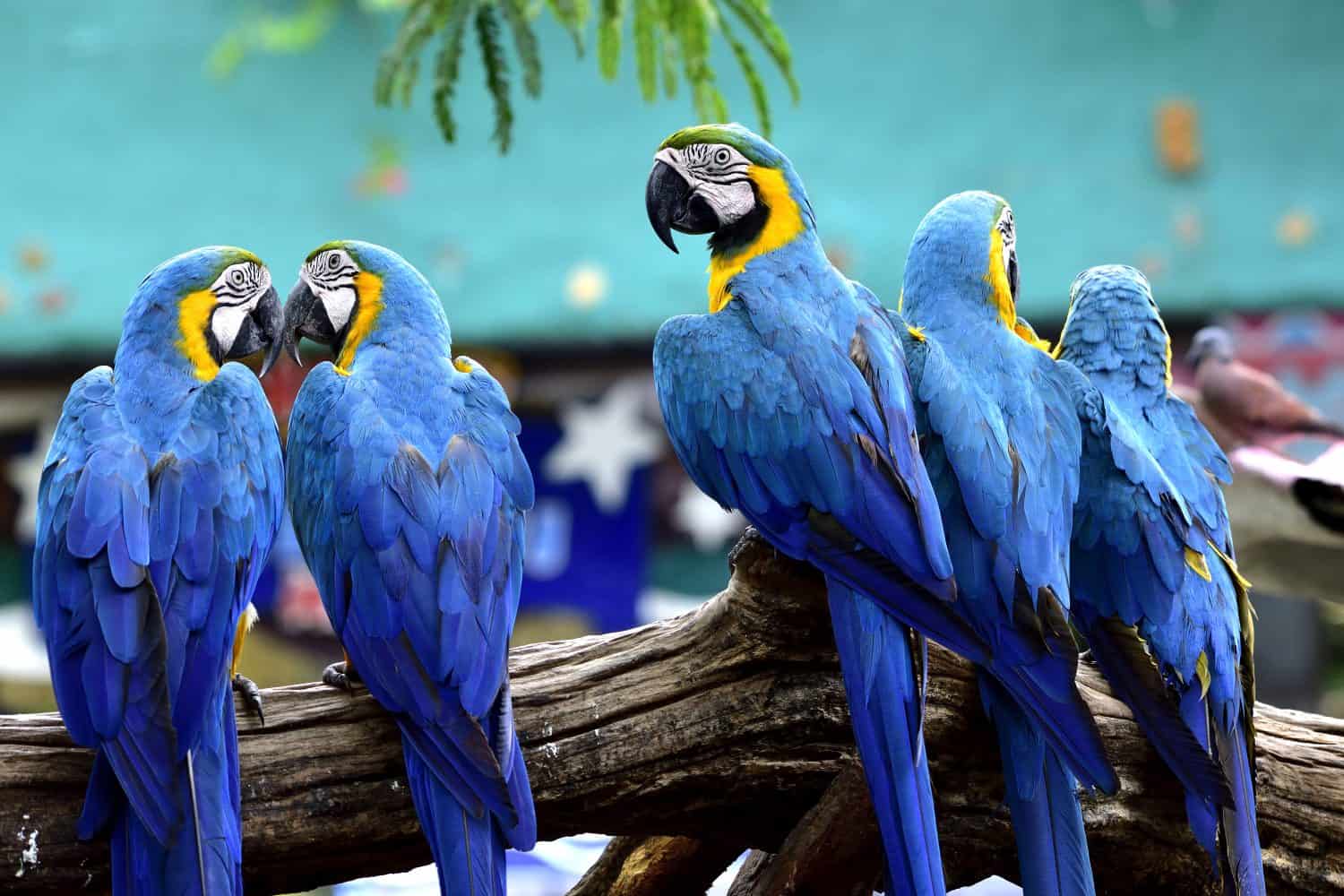
Blue and Gold Macaws live between 35 and 40 years in the wild. They sustain themselves on nuts, seeds, fruits, and other plant materials.
©Super Prin/Shutterstock.com
Surprisingly, Florida houses a flock of over 20 feral blue and gold macaws (Ara ararauna). They predominately live in Panama, Venezuela, Bolivia, Colombia, Paraguay, and Peru throughout Central and South America. This species favors tropical forests, woodlands, and savannas. Though not widespread, it is possible to spot this species soaring through the skies near Coral Gables, Pinecrest, and Palmetto Bay. They have been in Florida since the mid-1980s. It is important to note that this species is not native to Florida or any other part of the United States. Instead, these macaws came to Florida as escapees from animal exhibits, quarantine facilities, and private collections.
It is easy to identify this species in the wild because it is unlike any other bird in the state. Blue and gold macaws are identifiable by their vibrant, cobalt-blue exterior feathers and golden-yellow undersides. Blue and gold macaws typically have white faces with black patches on their throats. They also have much larger bodies than other parrots. Ranging in size, they can grow up to 35 inches long with a wingspan of 45 inches wide. A notable feature is their long, fanned-out tail. Both sexes look the same, but females have noticeably smaller, slimmer heads.
4. Orange-Winged Parrot
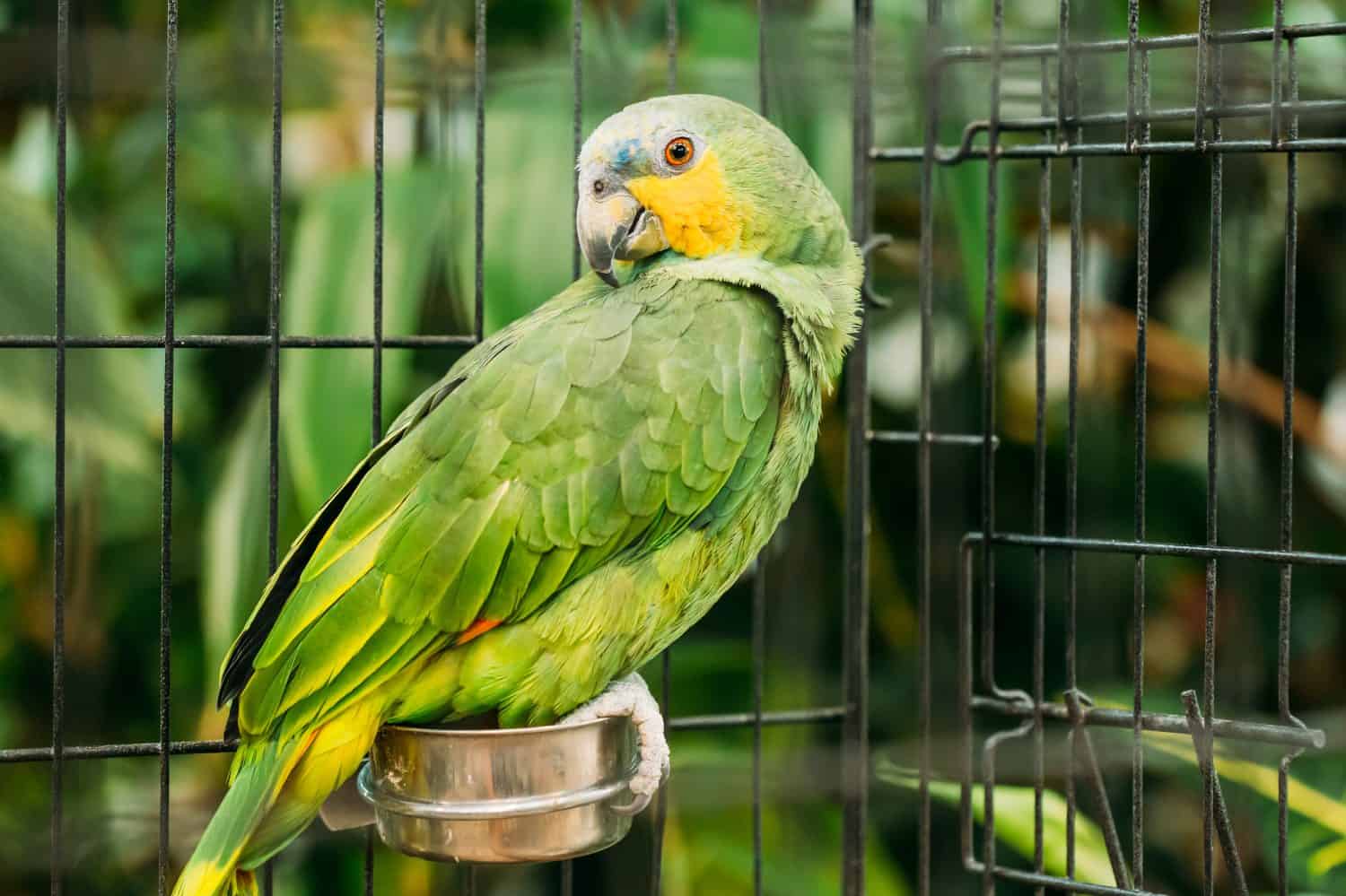
Orange-winged parrots are charismatic, entertaining, and highly talkative by nature. Their comedic personalities make this bird an ideal species to keep as a pet.
©Grisha Bruev/Shutterstock.com
Found most predominately in Miami and Fort Lauderdale, orange-winged parrots (Amazona amazonica) are another common bird species in Florida. Also called Loro Guaro, they are native to northern parts of South America, the Guianas, Brazil, and Trinidad and Tobago. This species thrives in tropical regions and inhabits forests, mangrove swamps, and grassy plains. Florida’s orange-winged parrot population is primarily found near urban parks and beaches. The most frequent locations for sightings are in and around Matheson Hammock, Brewer Park, Pompano Beach, and Miami Springs.
If you want to spot an orange-winged parrot, you can look for a few key traits. Even though most of their bodies are covered in bright green feathers, one of their most obvious identifiers is their wings. As the name suggests, the orange-winged parrot has noticeable bright orange and red patches across its wings. These unique markings can sometimes be seen when the bird is perched, but they are usually only visible during flight.
Along with their wings, their under-tail feathers are also orange. Typically, the rest of their tail feathers are green with pale yellow tips. Furthermore, these birds have a pale blue mask, a yellow crown, and bright yellow cheek markings. Orange-winged parrots are medium-sized birds with an average length of 13 inches from the top of their head to the tip of their tail. Like parrots, they can live to be over 50 years old!
3. Red-Crowned Amazon Parrot
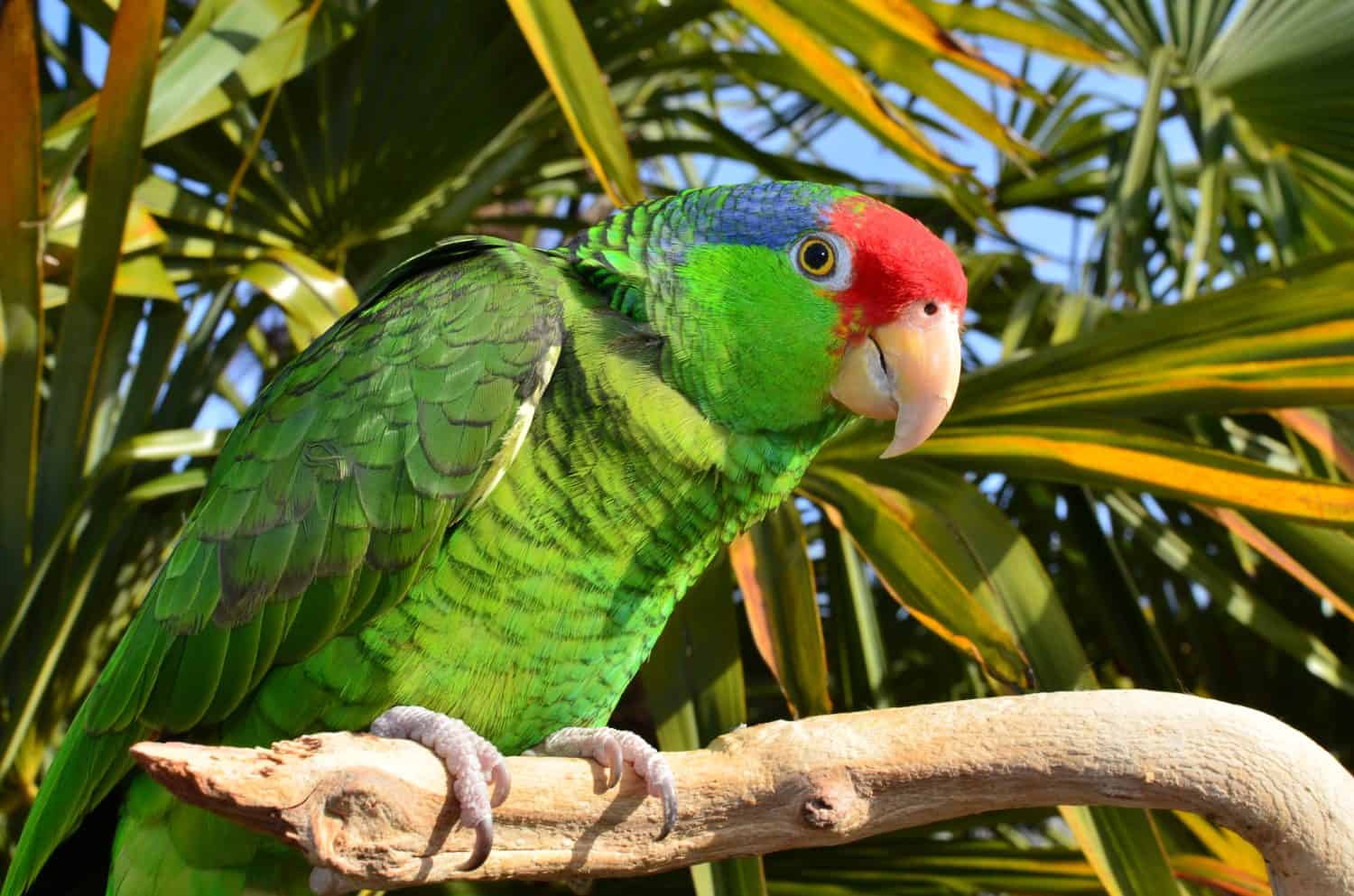
One clear way to distinguish birds’ moods is to look at their eyes. Since their pupils dilate and constrict easily, you can quickly identify if they are anxious, excited, interested, aggressive, or fearful.
©Tracy Starr/Shutterstock.com
Another common parrot species in Florida is the red-crowned Amazon (Amazona viridigenalis), the green-cheeked Amazon or Mexican red-headed parrot. Native to Mexico and other parts of Central America, these birds arrived in Florida due to a suspected smuggling operation gone awry. Today, they are one of the most endangered parrot species. The wild population of red-crowned Amazon parrots in Florida outnumbers the population in their native lands.
The combination of high levels of exploitation in the cage bird trade and long-term habitat loss are the two main reasons this species is declining rapidly in the wild. An estimated population of just over 400 of these birds living in Florida, spotted most commonly in the state’s southeastern cities. Although this may seem like a small number, experts welcome this increase because there are currently only a few thousand in the wild.
How Do You Identify Red-Crowned Amazon Parrots?
Often described as stocky or chunky, red-crowned amazons can grow up to 12 inches and have an average weight of 11 oz. Their wingspan is around 25 inches. The characteristic blue rings around their eyes and striking red crown serve as key identifiers for this bird species. In addition, their iris color ranges from a bright yellow to a deep red. Gray eyes indicate the bird is still a juvenile since the iris color changes around maturity. Males typically have more red showing than females, and females have red between their eyes instead of blue.
Red-crowned amazons also have red and blue feathers on their wings, with a yellow-colored band on the end of their tails. They have distinct vocalizations and are notorious for making much noise in the early morning and evening. Frequently heard whistling, squeaking, or screeching, this bird species is known for its distinct, explosive caw. Although some are excellent talkers and copy voices, they are best at mimicking sounds that stand out to them, such as car horns, animal vocalizations, or even telephones!
2. Nanday Parrot / Black-Hooded Parakeet
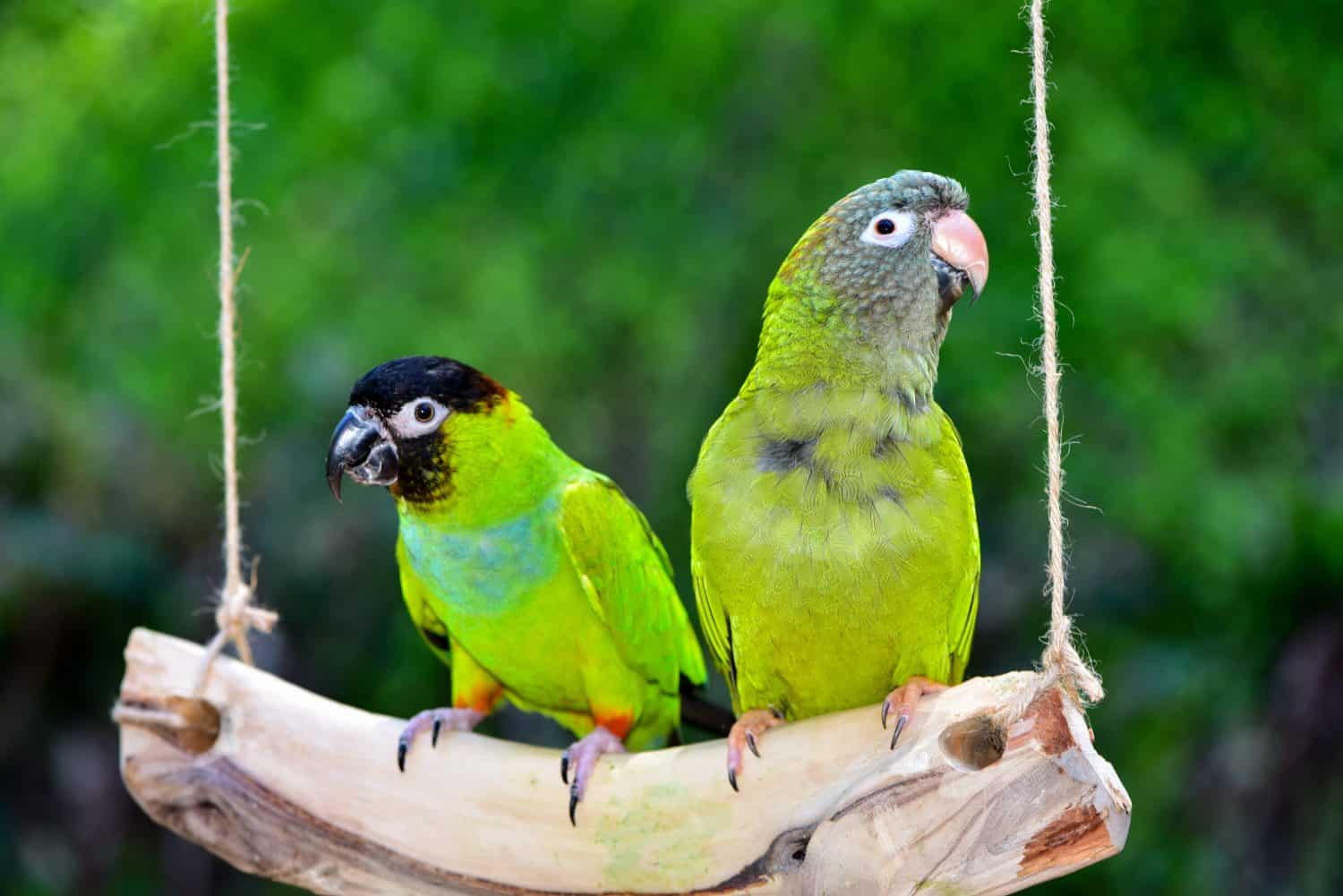
Black-hooded parrots were popular in bird-show exhibitions due to their high IQ. They are preferred over other bird species because of how quickly they can learn new tricks and vocalizations.
©Tracy Starr/Shutterstock.com
Florida’s second-most common parrot is the nanday parakeet (Aratinga nenday) or the black-hooded parakeet (Nandayus nenday). This species is not native to Florida. Instead, in 1959, a group of them were released from a pet store and became wild for the first time. Today, they can be found in the state — from the Florida Keys to as far north as Jacksonville. With an increasing population of around 1,000 birds, this beautiful species has more established populations in Miami and throughout Tampa Bay, especially in St. Petersburg.
Identifiable by their black “hooded” heads and dark-colored bills, nanday parakeets — a name derived from their indigenous South American name — have mostly green bodies with bright red thigh feathers. Some of these birds also have blue highlights on their wings and tails. These parakeets are medium-sized, measuring about 12 inches long and weighing a mere 4.9 oz. Thanks to their larger frames, males can sometimes be singled out from females. Besides that, there are no other common differences between males and females. The hood markings on their heads and beaks are usually much bolder than their female counterparts. Nanday parakeets also have a very distinct call, noted by their loud, repetitive screeching. While perched, they make a raspy, discordant chirping sound. They are known for their high-pitched calls heard during flight.
1. Monk Parrot / Quaker Parakeet
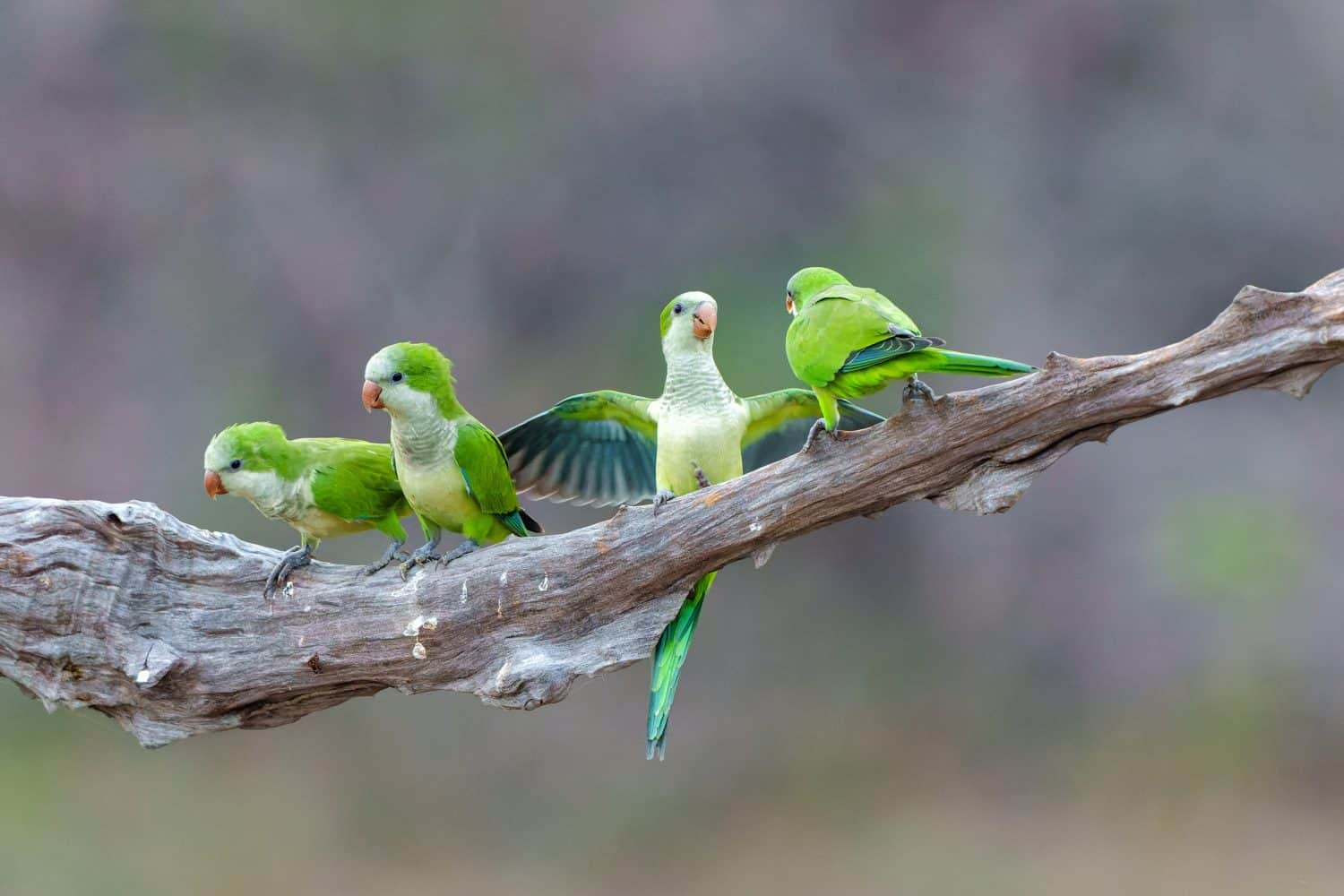
Quaker parrots reach sexual maturity by two to three years and eventually pair with another individual. They are monogamous birds, typically only mating and brooding with one partner for life.
©Henk Bogaard/Shutterstock.com
The Monk Parrot (Myiopsitta monachus) is the most common in Florida. This species goes by numerous alternate names, including the monk parakeet, Quaker parrot, or Quaker parakeet. Even though this species primarily resides in parts of Miami, West Palm Beach, and Tampa, they are found in all of Florida. Known for their quirky personalities, monk parrots originate from South America and thrive in temperate to subtropical areas. They have an average lifespan of 20–30 years. They grow between 11 and 13 inches long, measured from their head to the tip of their long, tapered tail. Females tend to be about 10–20% smaller than males, but this is not always an accurate measure.
How Do You Identify Monk Parrots?
To spot monk parrots, look for their small, bright-green bodies zipping through the skies. In flight, the primary and outer secondary flight feathers are visible. Most monk parrots have blue-tipped wings, which is another identifying factor to look for when identifying this bird. Along with their vibrant exterior color, they also have a subdued greenish-yellow abdomen, a notable grey face, and a subtle grey-yellow breast area. Their beaks are pale in color, with a slight pink or orange flush. Their legs are gray. If you find yourself up close and personal with this bird, brown eyes are the most common for this species.
Monk Parrot Vocalizations (and Other Identifying Factors)
Additionally, they are very vocal birds. While perched or at their nests, they have a characteristic call of short, chatty notes. They exhibit a much louder squawking call when they are in flight. Monk parakeets can learn to mimic human speech patterns if kept or raised in captivity. Furthermore, a key characteristic of monk parrots is that they build huge nests big enough for a community of 20 to 30 birds to live in. They are the only parrot species that builds their nests, so if you ever see a giant bird’s nest while traveling through Florida, know that a flock of these birds must be nearby!
Bottom Line

©Yongkiet Jitwattanatam/Shutterstock.com
To conclude, Florida is a tropical paradise perfectly suitable for various parrot species, and we identified the state’s most common parrots. We also explored how exactly to identify each species and looked into where they came from and where they can be found in the state today. From the vibrant plumage of the striking monk parrot to the quirky personality of the nanday parakeet, these feathered residents bring explosive color and beauty to the state. With that said, while these parrot species bring a sense of tropical wonder to Florida, these non-native birds impact the environment and other native species.
Negative Impacts of Non-Native Tropical Birds on Florida’s Ecosystem
Non-native parrots pose both negative and positive effects on Florida’s ecosystem. To start, the high presence of these tropical birds can disrupt local animals’ balance with the environment. It is common for native and non-native bird species to compete for food, nesting sites, and other critical resources. This competition can put additional stress on vulnerable native species, potentially leading to population declines. Additionally, non-native species can introduce new diseases that native species cannot handle. This further jeopardizes the native species’ health, wellness, and overall chances of survival.
By understanding the impact non-native parrots have on the environment and other birds in the state, we can work towards finding a balance that allows both bird groups to coexist in harmony. So, if you find yourself in the Sunshine State, keep your binoculars on hand to fully appreciate Florida’s extensive tropical parrot species!
Summary of the Top 5 Most Common Parrots Found in Florida
| Rank | Species |
|---|---|
| #1 | Monk Parrot / Quaker Parakeet |
| #2 | Nanday Parakeet / Black-Hooded Parakeet |
| #3 | Red-Crowned Amazon Parrot |
| #4 | Orange-Winged Parrot |
| #5 | Blue and Gold Macaw |
The photo featured at the top of this post is © Charles Bergman/Shutterstock.com
Thank you for reading! Have some feedback for us? Contact the AZ Animals editorial team.







